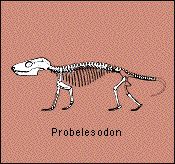Fossils and the history of life - How are fossils formed?

Sediment upon sediment
Once an organism's remains have been buried in the sediment, they can remain there, potentially, for an indefinitely long period of time. As new sediment piles on top of older sediment, the lower sediments are compacted: water is squeezed out and the sedimentary particles forced closer together. The fossil hard parts may be destroyed or deformed in the process. As the sediments compact, they are gradually turned into sedimentary rock. They may subsequently be moved up, down, or around the globe by tectonic movement, and can be re-exposed in a terrestrial area.
Once a fossilized organism has been discovered, paleontologists can reconstruct its anatomy and often make surprisingly detailed inferences about its physiology and behavior. From a few fragments, entire skeletons can be scientifically drawn, as with this diagram of Probelesodon (an early mammal) opposite.
On the following screen, Simon Conway Morris analyses a Permian Coral.
| Next |



